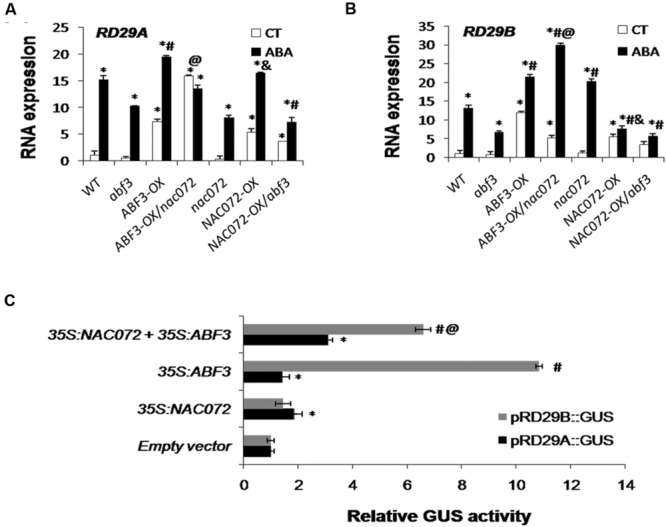FIGURE 3.

NAC072 cooperates with or antagonizes ABF3-mediated ABA-responsive gene regulation. (A) Expression of RD29A in each mutant, transgenic line and WT plants under control treatment (CT) or 100 μM ABA treatment (ABA) for 2 h. ‘∗’ or ‘#’ indicates a significant difference between ABF3 or NAC072 transgenic plants compared with WT or abf3 and nac072 plants under CT and ABA treatments, respectively (P < 0.05). ‘@’ indicates a significant difference between ABF3-OX and ABF3-OX/nac072 plants (P < 0.05). ‘&’ indicates a significant difference between NAC072-OX and NAC072-OX/abf3 plants (P < 0.05). (B) RD29B in each mutant, transgenic and WT plants under CT or ABA treatment for 2 h. ‘&’ indicates a significant difference between NAC072-OX and nac072 mutants. (C) Transactivation of the RD29A or RD29B promoter-GUS fusion gene by ABF3 and/or NAC072 in Arabidopsis protoplasts. The reporter gene was transfected with each effecter plasmid (35S:ABF3 and/or 35S:NAC072) or the empty vector as a control groups. Co-transfection of the 35S driving luciferase (LUC) plasmid was used in each experiment to normalize transfection efficiency. Protoplasts were prepared from rosette leaves of 4-weeks-old WT. Bars indicate standard deviation, n = 3. ‘∗’ or ‘#’ indicates a significant difference between ABF3 or NAC072 groups compared with control groups (P < 0.05). ‘@’ indicates a significant difference between ABF3 and NAC072 compared with ABF3 alone (P < 0.05).
